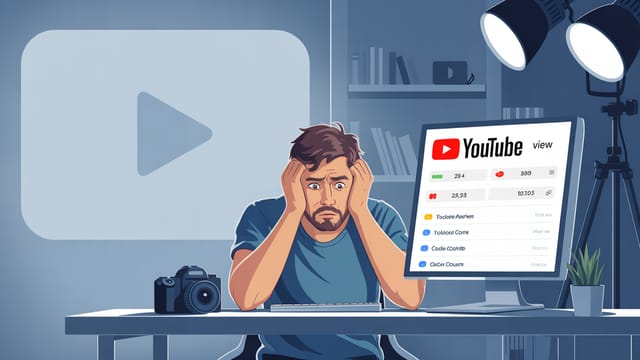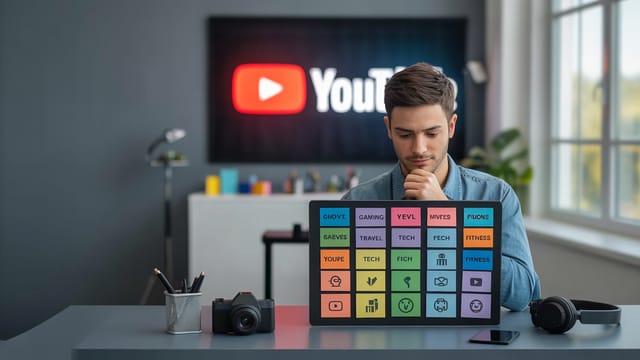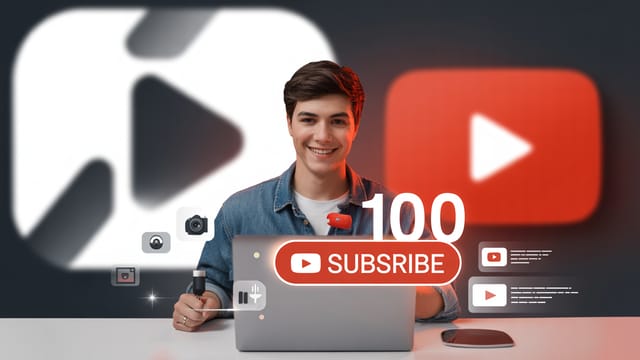
Ready to get your next 10,000 subscribers?
Join thousands of creators who use Subscribr to create faster, better YouTube videos.
Confused by YouTube Analytics? Your Simple First Step to Understanding Your Data
Feeling overwhelmed every time you click into YouTube Studio? You're not alone. For many new creators, the sheer volume of charts, graphs, and numbers in YouTube Analytics can feel like trying to read a foreign language. Where do you even start? What do all these metrics mean for your channel? And more importantly, how can looking at this data actually help you grow and eventually make money on YouTube?
If you've been avoiding analytics because it feels too complicated, you're missing out on crucial insights. But the good news is, you don't need to become a data scientist overnight. There's a simple, practical first step that can unlock the power of analytics without the headache.
This article will guide you through that crucial first step and show you which key analytics to focus on when you're just starting out. We'll cut through the complexity and give you actionable ways to use your data to make smarter decisions about your content.
Why Bother with Analytics As a Beginner?
You might think, "My channel is small, why do I need analytics?" The truth is, analytics are even more important when you're starting. They are the feedback loop from your audience and the YouTube algorithm. Without looking at your data, you're essentially creating content in the dark, guessing what works and what doesn't.
Understanding your analytics is the key to:
- Knowing what your audience actually wants: Your viewers' behavior tells you what topics they love, what formats keep them watching, and where they lose interest.
- Understanding how people find you: Are they searching? Clicking from the homepage? Coming from external sites? This informs your strategy.
- Identifying what content performs best: You can see which videos resonate most and create more content like that.
- Making data-driven decisions: Instead of relying on intuition, you use real numbers to guide your content creation, packaging, and promotion.
- Accelerating growth: By focusing on what works, you can improve your content and reach more viewers, leading to faster subscriber growth and getting you closer to monetization.
YouTube Studio provides incredibly detailed data, offering insights into audience activity times, drop-off points in videos, and whether viewers are subscribed or not. While becoming an analytics expert takes time, starting now is the most effective way to use this powerful information to refine your content strategy.
The Simple First Step: Don't Look at Everything
The biggest mistake beginners make with YouTube Analytics is trying to understand everything at once. That's what leads to feeling overwhelmed.
Your simple first step is this: Ignore most of it.
Seriously. You don't need to track dozens of metrics or analyze every single graph when you're starting. Trying to do so will just confuse and discourage you.
Instead, focus on a few key metrics that give you the most critical information about your channel's performance. Think of it as an 80/20 approach – focus on the 20% of data that gives you 80% of the insights you need right now.
Your Starting Point: The Key Metrics for Beginners
When you're just beginning, there are a handful of core metrics that provide the most actionable insights. Don't worry about the rest for now.
Here are the essential analytics to focus on first:
1. Views
This is the most basic metric, but still fundamental. Views tell you how many times your video has been watched. While not the only thing that matters, views are the primary goal of the YouTube system – getting your content seen.
- What to look for: Look at the total views over the last 28 days or 90 days to get a sense of your channel's overall reach. More importantly, look at views per video to see which ones are getting the most attention.
- What it tells you: Which topics, titles, and thumbnails are most effective at getting people to click and watch.
2. Watch Time (and Audience Retention)
Watch Time is the cumulative amount of time viewers have spent watching your videos. YouTube's algorithm heavily favors Watch Time because it indicates that your content is engaging and keeping people on the platform. Audience Retention is the percentage of your video that viewers watch, shown as a graph for each video. This is arguably one of the most important metrics for beginners.
- What to look for:
- Overall Watch Time: See the total Watch Time for your channel over the last 28/90 days. This contributes directly to your monetization eligibility (4,000 valid public watch hours).
- Audience Retention Graph (per video): Look at the graph for each video. Pay close attention to:
- The first 30 seconds: Is there a steep drop-off? This indicates issues with your hook or intro – you're not grabbing viewers fast enough.
- Significant dips: Where do viewers consistently leave? Watch your video alongside the graph to understand why they might be dropping off at those specific moments. Is the pacing slow? Is there a confusing section? Did you promise something in the intro that you haven't delivered yet?
- Peaks: Are there parts viewers are rewatching? This shows what they found most engaging.
- What it tells you: How well your content holds attention. A high retention means viewers are engaged. A low retention, especially early on, signals a problem with your content structure, pacing, or hook. Analyzing specific drop-off points helps you identify exactly what needs improvement in your video editing or scripting.
3. Click-Through Rate (CTR)
CTR measures how often viewers watch a video after seeing its thumbnail and title on YouTube (e.g., on the homepage, in search results, or suggested videos). It's calculated as Clicks / Impressions.
- What to look for: Look at the CTR for individual videos under the "Reach" tab in YouTube Studio. YouTube provides benchmarks for what a typical CTR is based on where the impression occurred, but generally, a higher CTR is better.
- What it tells you: How effective your video packaging (thumbnail and title) is at grabbing attention and making people want to click. If a video has a low CTR but decent retention, it means the content is good, but the packaging isn't enticing viewers to click in the first place. If it has a high CTR but low retention, the packaging is great, but the content isn't delivering on the promise.
4. Traffic Sources
This metric shows you where your viewers are coming from. Are they finding you through YouTube Search, Suggested Videos, YouTube Home, External sources (like social media), or Channel Pages?
- What to look for: For beginners, pay special attention to "YouTube Search."
- What it tells you:
- YouTube Search: This is crucial initially because people who don't know your channel yet often find you by searching for specific topics. The search terms that lead people to your videos reveal exactly what your potential audience is looking for. Use this data to brainstorm future video ideas that you know there's existing demand for.
- Suggested Videos/YouTube Home: As your channel grows, traffic from these sources becomes more important, indicating the algorithm is recommending your content.
5. New vs. Returning Viewers
This metric splits your audience into those who have watched your channel before (Returning) and those who haven't (New).
- What to look for: Look at the percentage split in the "Audience" tab. You can also see separate Audience Retention graphs for New and Returning viewers ("See More" in analytics).
- What it tells you:
- High percentage of New Viewers: You're successfully reaching new audiences, which is great for growth. However, new viewers might have lower retention if they're not yet familiar with your style.
- High percentage of Returning Viewers: You're building a loyal community, which is fantastic for consistent views and engagement. Returning viewers typically have higher retention.
- Analyzing Retention Split: If new viewers drop off quickly but returning viewers stay, you might be using too much jargon or channel-specific references that alienate first-time watchers.
Beyond the Numbers: Looking at Your Content
While the core metrics are your starting point, analytics also help you analyze your actual videos.
- Top Performing Content: Look at your videos sorted by views or watch time over the last 90 days. What do these successful videos have in common? Is it the topic? The format? The thumbnail style? The hook? Find the patterns and create more content based on those successful elements. Success leaves clues!
- Least Performing Content: Look at videos with low views or retention. Why didn't they resonate? Avoid repeating the same mistakes unless you have a clear plan to significantly improve the topic or execution.
- Comments: Don't just look at numbers! Read the comments on your videos. Viewers often ask questions, suggest topics, or point out confusing parts. This is invaluable qualitative data that complements the quantitative analytics.
Putting It Into Practice: Pick One Metric to Improve
Now that you know which metrics to focus on, here's a highly actionable first step recommended by experienced creators:
Choose ONE specific analytic to focus on improving over the next 30 days.
Pick one of the key metrics discussed above that you want to impact – perhaps your Audience Retention in the first 30 seconds, or your CTR. Actively monitor only that metric for your new uploads during this period. Implement specific strategies aimed at improving that single number.
For example:
- If you choose CTR: Focus intensely on crafting compelling titles and designing scroll-stopping thumbnails for every video you upload. Monitor the CTR for those new videos.
- If you choose First 30 Seconds Retention: Spend extra time crafting an irresistible hook for your videos. Experiment with different intro styles. Monitor the retention graph specifically for the beginning of your new uploads.
This focused approach makes analytics less daunting and allows you to see the direct impact of your efforts on a specific aspect of your channel's performance.
Using Subscribr to Simplify Your Analytics Journey
Understanding and acting on analytics is crucial for growth, and platforms designed for creators can significantly simplify this process. While YouTube Studio is your primary data source, tools like Subscribr are built to help you interpret that data and turn insights into content.
Instead of getting lost in spreadsheets, Subscribr's Intel features and Research Assistant help you analyze your channel's performance, identify top content, and even research what's working for others in your niche. By integrating analytics with content planning and scriptwriting, Subscribr empowers you to use data to inform every step of your creation process, from idea generation to final script. This data-driven approach is key to creating content that resonates with your audience and accelerates your path to monetization.
Your Next Step
Don't let YouTube Analytics intimidate you any longer. Start simple. Focus on the core metrics: Views, Watch Time/Retention, CTR, Traffic Sources (Search), and New vs. Returning Viewers. Look at your top and least performing content. And for a practical exercise, pick just one metric to actively try and improve over the next month.
By taking this simple first step and consistently (but not obsessively) checking these key indicators, you'll start to understand the story your data is telling you. This understanding is the foundation for making informed decisions, creating better content, attracting more viewers, and ultimately, growing a successful and potentially monetized YouTube channel.





